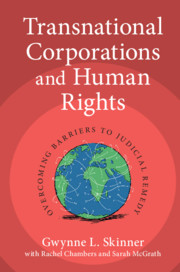Book contents
- Transnational Corporations and Human Rights
- Transnational Corporations and Human Rights
- Copyright page
- Dedication
- Dedication
- Contents
- Foreword
- Abbreviations
- Table of Cases
- Table of Statutes
- Introduction
- Part I Rise of Transnational Corporations, Impact on Human Rights, And Victims’ Rights to Remedy
- Part II Legal Barriers to Remedy and How to Overcome Them
- Conclusion
- Select Bibliography
- Index
Conclusion
Published online by Cambridge University Press: 04 September 2020
- Transnational Corporations and Human Rights
- Transnational Corporations and Human Rights
- Copyright page
- Dedication
- Dedication
- Contents
- Foreword
- Abbreviations
- Table of Cases
- Table of Statutes
- Introduction
- Part I Rise of Transnational Corporations, Impact on Human Rights, And Victims’ Rights to Remedy
- Part II Legal Barriers to Remedy and How to Overcome Them
- Conclusion
- Select Bibliography
- Index
Summary
One purpose of this book was to illustrate the power imbalance between a TNC and the communities it serves. TNCs benefit immensely through operations in developing countries that often have fragile governments and judicial systems. Nonconsenting community members, meanwhile, absorb nearly all the risk and costs – to their lives, health, and livelihoods – and are usually unable to achieve judicial remedy for harms they suffer. This paradigm is not fair, moral, or sustainable, either legally or economically.
- Type
- Chapter
- Information
- Transnational Corporations and Human RightsOvercoming Barriers to Judicial Remedy, pp. 158 - 160Publisher: Cambridge University PressPrint publication year: 2020

